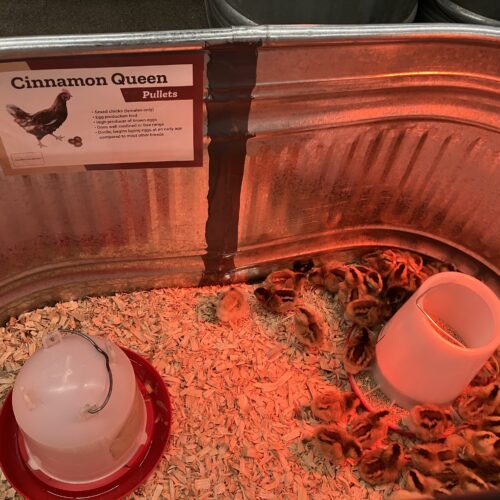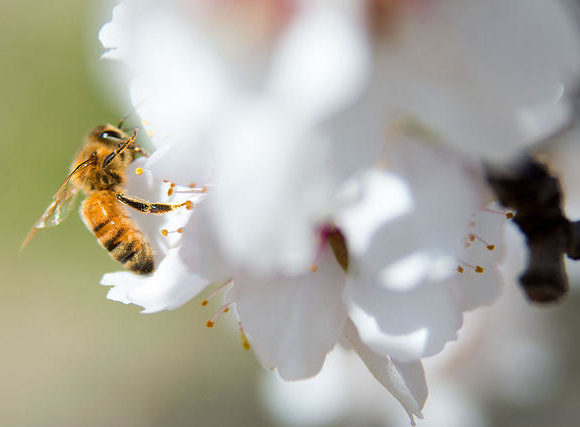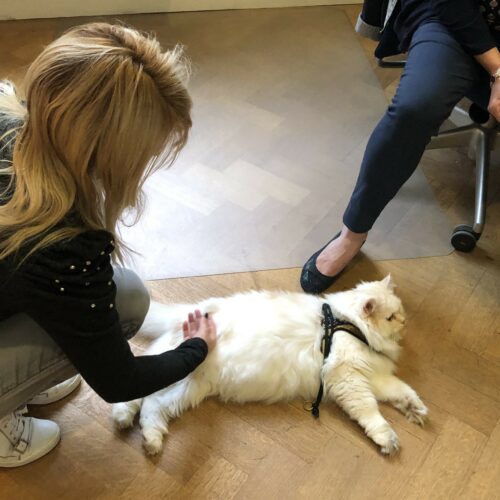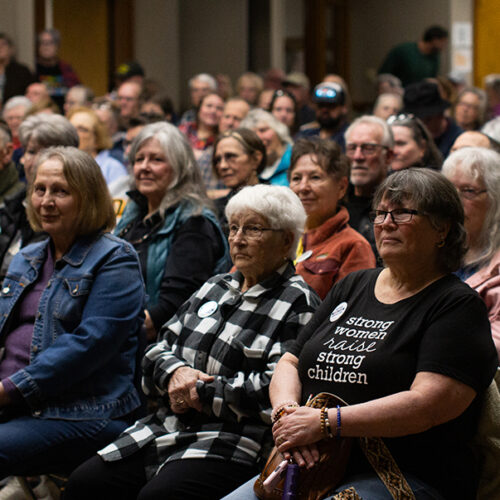Growing Weeds And Feeding Bees: Beekeepers And Farmers Work To Help Honey Bees Thrive
Forty-two percent of America’s honey bees died in 2014. On average, beekeepers lose about 30 percent of their colonies annually – a number seen since 2006. As a trend, the numbers look even worse. In the 1940s there were 5 million managed honey bee colonies. Today, there are half as many.
This has many worried about the future of American agriculture. Farmers need bees to pollinate their crops. Beekeepers need plants on which their bees can feed. But those plants aren’t always ones farmers want on their land. That’s making it tough for some farms to get enough bees, and difficult for beekeepers to recover from their annual losses.
The problem isn’t just a matter of the total number of bees. It’s about the economics of beekeeping – and whether it’s worth the risk to stay in the industry.
The Hard Work And High Risk Of Beekeeping
“The problem isn’t necessarily always a loss of bees or colonies, it’s a loss of beekeepers,” Brandon Hopkins says. He’s a honey bee researcher at Washington State University.
Beekeepers can recover from losses, and regularly do. After all, about a third of their bees die each year on average. Commercial producers are very good at breeding enough bees, and they can always buy more from other beekeepers. There are even nukes – a beekeeper’s term for a small colony with an active queen that can be cultivated into a full-size honey bee colony.
But that doesn’t mean it’s easy. Matthew Shakespear, vice president of Olson Honey in Yakima, says he’s gotten about three hours of sleep a night for the past several weeks. That kind of work can turn people off of beekeeping.
“There are new people coming in, but often those new people don’t last very long, because they run into a few difficult years,” Shakespear says.
There’s a lot of money to be made in bees, but it also takes significant investment – and risk.
“There’s no easy or cheap solution to doing that,” Shakespear says. “You have to invest the money into keeping them alive. Oftentimes the newcomers in the industry are reluctant to do that. They would prefer to preserve their profits and spend it on something else.”
Addressing the economic problems of beekeeping means figuring out how to keep more bees alive.

A honey bee colony at Olson Honey in Yakima.
Photo credit: Matthew Shakespear / Olson Honey
Why Are So Many Bees Dying?
The most publicized reason for honey bee losses has been Colony Collapse Disorder (CCD), a condition in which adult bees can disappear from a colony, leaving behind a live queen and young (known as brood), but no dead bees. But CCD cases have decreased since 2011. Survey reports for the 2014-2015 year don’t consider it a major factor.
“There’s big colony loss, colony collapse disorder stuff in the media,” Hopkins says. “But I think bee numbers have remained pretty steady. Maybe even increased in the overall number of colonies.”
So why are so many bees dying, year after year?
There are a few causes of honey bee loss for commercial apiaries – disease, pests, and various stressors – but two stand out. The first is varroa mite. Scientifically – and appropriately – classified Varroa destructor, these tiny insects latch onto both adult bees and brood, draining them of blood. They can cause deformities, transmit viruses to bees, and quickly kill a colony. Battling varroa is a constant struggle for beekeepers, but chemical treatments can be effective, although they are hard on bees.
The second threat is less dramatic, but just as crucial: bees don’t have enough to eat.
The Challenges Of Feeding Honey Bees

A honey bee feeds on clover. Many varities of clover are valuable forage for honey bees – if they have access to it.
Photo credit: Jimmy Smith / Creative Commons
Like us, bees need protein and carbohydrates to survive. Honey bees get their carbohydrates from flower nectar. And there are artificial substitutes. Beekeepers sometimes feed their bees a mix of sucrose and fructose, pumped into feeders in beehives.
“Most farm animals, we’ve figured out how to keep them alive on food we can provide them,” Matthew Shakespear says. “But if we were to just stick bees in a room and provide them with our version of their food, they wouldn’t last more than about two months before the hive would be dead.”
That’s because bees also need pollen for protein. Pollen also contains essential amino acids and trace minerals for bee health. That’s hard to substitute, and that means bees need natural forage – wild and domestic plants they can feed on.
Olson Honey has between 16,000 and 18,000 hives. They make a living renting out bees to farms and orchards that need pollinators. When that’s happening, bees can feed off the plants they pollinate. Those sources aren’t available year-round. And many of the other plants bees need are weeds, which farmers work hard to get rid of.
“We’ve kind of gone to the big ag model where we have the big circles, the big fields, where even the corners don’t have any weeds,” Shakespear says.
This means that once crops are done blooming, there’s nothing for bees to eat. So it can be hard for Washington apiaries to keep their bees in the state.
“If you talk to commercial beekeepers here in the state, they used to be able to keep their bees here year-round,” Brandon Hopkins says. “As soon as apples are done, they move all their bees to Montana, North Dakota, South Dakota.”
Those states are home to Conservation Reserve Program lands, many of which grow clover – an excellent plant from a bee’s perspective. That also gives beekeepers a chance to produce honey. But they make most of their money from a single source: almonds.

Seen up close, honey bees cluster in large numbers at Olson Honey.
Photo credit: Matthew Shakespear / Olson Honey
Why Beekeepers Need Almonds – And Vice Versa
You can’t discuss the problems of bee nutrition – or the commercial bee industry at all – without talking about almonds. Bees and almonds have a special relationship. Every year, almond orchards in California rent upwards of 1.6 million colonies to pollinate their trees. That’s about 60 percent of all the colonies in the country. Almond season is the biggest moneymaker for most commercial apiaries.
“If it were not for the income we receive from the orchards in California, commercial beekeeping would not exist,” Shakespear says. “That industry in particular, because of what they pay for the bees, makes it possible for beekeepers to continue to exist, in the face of varroa mites and the lack of forage.
But it can be tough for almond producers to find enough bees, especially since almond trees begin to bloom in February. Apiaries face the majority of their losses in winter, just before the bloom. And this year, almond orchards faced a honey bee shortage. That’s one reason some almond orchards are working to become less dependent on bees, with efforts to grow self-fertilizing trees.
For now, they need a lot of bees. Around 31 billion every year. After the bloom is over, they all have to go somewhere. Constantly moving bees can be stressful. It may even contribute to those high annual losses.
Keeping the bees where they are isn’t often an option. There’s not enough forage in almond orchards after the bloom is over, for the same reason there’s not enough on Washington farmlands: plants that are good for bees aren’t always good for farmers.
So what’s being done to fix it?
Mustard, Radishes, And Other Plants That Aren’t Almonds
Project Apis m. is a non-profit working to improve honey bee health. They’re behind the Seeds For Bees project, working to get more bee-friendly plants into almond orchards.
“There’s situations where a beekeeper will drop their bees off in that orchard, and it can be a few days or a week before the almonds will bloom,” says Billy Synk, manager of the Seeds For Bees project. More forage means bees have enough to eat before and after the almonds bloom.
They’ve settled on four species of clover, two varieties of mustard, canola, and daikon radish. Daikon flowers are good for bees, and their enormous roots are beneficial to farmers, breaking up the soil and eventually decomposing into useful fertilizer. Clover is also good for the soil, a nitrogen-fixing legume that makes for more fertile land. They’re also inexpensive to distribute.
Almond growers didn’t take to the project right away. Many were concerned about competition. After all, they pay a lot of money for bees to pollinate their almonds. Why would they want their honey bees flying to other flowers? Synk says that’s just not how bees work.
“When almonds bloom, bees don’t know it’s going to last. In their minds, they’re hedging their bets, they’re making sure they’ve found something else,” Synk says. “The bees will pollinate the almonds in the morning, then switch to the cover crops in the afternoon. You just want to attract as many bees as you can to your orchard.”
It’s a message producers have begun to embrace. Synk says enrollment has nearly doubled each year since the project began in 2013. Last year, they planted more than 3,000 acres of bee forage with help from 145 orchards.
Similar efforts are underway in the Northwest.
Washington Legalizes Weeds

Honey bees are kept in canola fields at Washington State University’s Pullman campus. Canola is another useful plant for bee nutrition.
Photo credit: Brandon Hopkins / Washington State University
“A lot of our noxious weeds, while they have very serious negative impacts for agriculture, they still provide nectar and pollen to honey bees and other pollinators,” Alison Halpern says. She’s the executive secretary for Washington’s Noxious Weed Control Board (NWCB). They do what their name says – control and remove noxious weeds in the state. Those weeds do a lot of damage to Washington.
“We really want to get that message across that these noxious weeds are detrimental to our agriculture, and completely overwhelming our ecosystems,” Halpern says.
But honey bees need the forage, and so do other pollinators like butterflies. So the NWCB want people to grow more weeds – just better ones. Last year, they gave out about 70,000 seed packets to farmers. Those packets contained non-invasive weeds such as crimson clover and blue sage, alongside another 16 different flowering plants. They’re not native to Washington, but they also aren’t prolific and invasive. They’re also inexpensive.
Now, the state wants more efforts to introduce bee-friendly plants. House Bill 2478 was signed into law this year. It creates a pilot project over the next four to five years to continue and improve distribution of pollinator-friendly weeds. That project will focus on native species, which weren’t a viable solution short-term.
“With the native species, there are more perennial native species that are pollinator-friendly,” Halpern says. “They’re going to take more time to nurture and flower year after year.”
That’s going to take some careful plant selection to find a mix that’s good for bees, good for farmers, and not too pricy. But if it works, it could be, as Halpern describes, “a win-win-win.”
What Does The Future Hold?
The biggest question for the industry remains not whether the honey bee will survive. It’s whether or not commercial beekeeping is economically sustainable. In short, will beekeepers stay in the business? Matthew Shakespear isn’t sure.
“The population of beekeepers is aging. But I have seen, in the last five or six years, younger beekeepers getting into it. The big concern there is, how long are they going to last? Because I’ve seen a few who get into it and after a few years they get frustrated, run into trouble keeping their bees alive, and get out of it.”
In short, Shakespear says, “I don’t really feel [the industry] doing very well.”
With scientists, beekeepers, and agencies across the nation working to save the honey bee, there’s reason to hope. But there are no easy answers.
Copyright 2016 Northwest Public Broadcasting
Related Stories:

What’s fuzzy, cute and sold out? Chicks
As egg prices surge, baby chicks have been selling out across the region — and the country. (Credit: Susan Shain / NWPB) Listen (Runtime 3:59) Read The first person showed

Searching for sage grouse: Looking for a chicken-sized needle in south-central WA
Seth Hulett, Audubon Washington’s senior program manager of the Columbia Plateau, searches through his spotting scope for sage grouse. (Credit: Courtney Flatt / NWPB) Listen (Runtime 4:12) Read In south-central

Dozens in Yakima rally to support science for national protest
Around 50 people gathered for Yakima’s Stand Up for Science rally on Friday. People around the country attended science protests at the same time. (Credit: Courtney Flatt / NWPB) Listen















